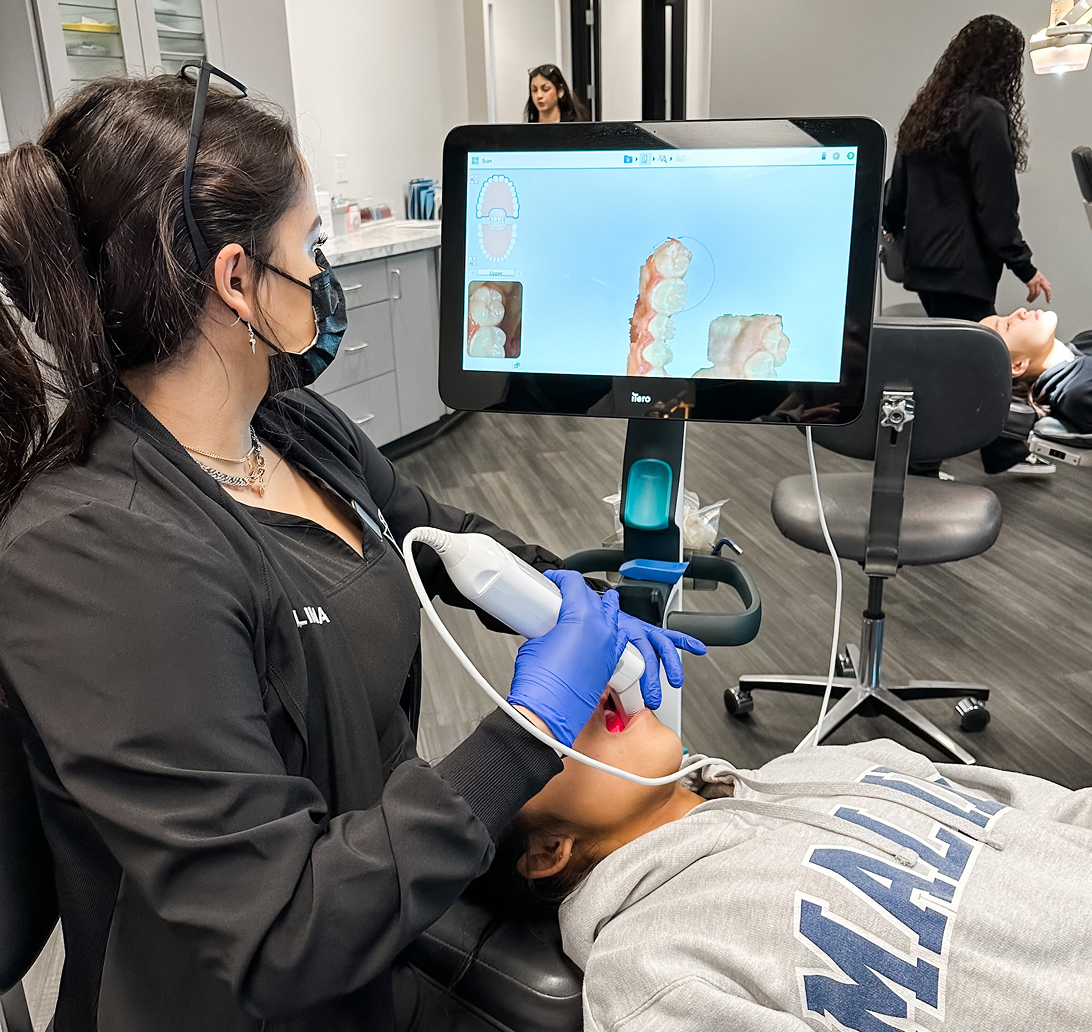You already know that maintaining good oral hygiene is important for everyone — but when you’re having orthodontic treatment, it’s even more critical. Why? Because, while the appliances (such as braces or clear aligners) you may need to wear during treatment are very effective in correcting misaligned teeth, they can also trap food particles easily. Keeping your teeth (and your appliances) clean is a little harder — but you can do it! Here is a look at why good oral hygiene is so important during orthodontic treatment, and some tips on how you can keep it up.
Patient Care & FAQ
Your Care, Explained
What to expect, how to prepare, and answers to your top questions.
Patient Care

Healthy vs. Unhealthy
The major enemy of oral health is plaque. Food that becomes trapped near tooth surfaces can lead to the formation of plaque — a thin coating of microorganisms and organic debris (biofilm) containing potentially harmful bacteria. Braces or other appliances make it harder to remove plaque. The bacteria in plaque interact with the sugars in food, producing acids which may erode teeth and irritate gums. This can cause cavities, white spots on teeth, gum disease and bad breath.
Keeping plaque under control is one of the most effective means of maintaining strong, healthy teeth and gums. There are three general ways to keep plaque under control: diet, daily maintenance and regular professional care. Taken all together, they are your teeth’s best defense.
Diet and Decay
Controlling your diet involves avoiding foods that could increase your risk of developing tooth decay. That means cutting down or eliminating foods with an excess of sugar, like soda, sweets, and ice cream. It also means avoiding foods that could easily become stuck in your braces, like toffee, gum, licorice and caramels.
Foods that are very hard or extremely sticky can also cause physical damage to orthodontic appliances. Certainly, braces or retainers with broken wires or loose brackets won’t work to straighten your teeth! You should avoid foods like hard candies or nuts, beef jerky and hard pizza crust. Keep eating healthy foods like carrots and apples — but cut them into bite-sized pieces first! Do not chew on ice, pencils, or your nail — these habits can cause damage to your appliances, and can even result in chipped teeth!
How to Clean Teeth With Braces
You know how important brushing and flossing are for keeping a healthy smile — especially now that you’re in orthodontic treatment. But sometimes, it’s harder to clean your teeth effectively around an appliance’s brackets and wires. Here are some tools and tips you can try for better tooth cleaning.
Either a soft-bristle or a bi-level toothbrush (one with longer bristles on the edges and shorter ones in the middle) can be effective in plaque removal — even with braces. An electric toothbrush can also be used, on a moderate setting. For hard-to-clean areas, try an interdental brush or a Proxabrush®. The small bristles of this special tooth-cleaning aid, which is shaped like a pipe cleaner, can get in between wires, brackets and teeth. With gentle and persistent effort, it’s possible to reach into the smallest nooks and crannies, and control plaque buildup.
You should floss at least once a day during the course of your orthodontic treatment. While it’s a little harder to do with braces, there are some special products available, such as floss threaders and particular kinds of floss, that can help you floss between your wires and gum line. Our staff will review proper brushing and flossing techniques with you when you get your braces — but if you ever have questions, don’t hesitate to ask!
Depending on your situation, we may recommend an in-office or at-home supplemental fluoride treatment to boost your cavity resistance. We may also suggest using an antiseptic rinse to ease minor gum inflammation or irritation.
How To Clean Removable Retainers
If you have a retainer, it should be brushed daily, the same way you brush your teeth. We may also recommend using a cleaning solution — but never put hot water on your retainer, because it can warp the soft plastic and make your retainer unusable! Always keep your retainer in a case when it’s not in your mouth.
Professional Care
Even though you’re seeing our orthodontists regularly, that doesn’t mean you don’t need to see your regular dentist — in fact, it’s just as important as ever! While we’re focused on improving your bite and alignment, your dentist will make sure your teeth stay healthy with thorough examinations, cleanings and preventive care. Your orthodontic treatment is a team effort where everyone — our office, you, and your family dentist — has an important role to play. And the team has just one goal: giving you a winning smile.
If you would like more information on good oral hygiene during orthodontic treatment in Temecula and Hemet, California, please contact Miles of Smiles today to schedule an appointment with Dr. Tal Jergensen, Dr. Scott Hope or Dr. Kaileen Rodriguez!
Frequently Asked Questions
Our orthodontists have prepared this orthodontic FAQ page to help answer some basic questions or concerns you may have about orthodontic treatment and planning.
Why do I want an orthodontist instead of a dentist when I’m looking for orthodontic treatment?
Dentistry covers many practices, but some are specialized. Orthodontics is a specialized area for a few reasons. First, orthodontics is best utilized at specific ages. Therefore, age must factor into the treatment. Accurate growth indicators and growth factors must be considered to ensure that permanent damage is not done to the facial structure or the mouth. Second, orthodontists are trained not only in implementing orthodontic appliances, but also in aligning teeth and restructuring the mouth and related areas, including the jaw. Third, at Miles of Smiles, we are only orthodontists. We don’t practice any other dental procedures. This gives us unique skills, a focus that is geared specifically to your success in orthodontic treatment, and the ability to give you a personal, comfortable treatment experience.
What age is appropriate to investigate orthodontics for my children?
At around age 7, we start seeing key indicators in the growth and development of children that signal that the opportunity for analysis exists. That doesn’t mean it’s inappropriate to start treatment at 5 or 6, or slightly later than 7 years old. It does mean that, optimally, we would want to track the growth and changes in your child’s mouth. At 6 or 7 years, we can begin to see what goals we can set for the months and years ahead and make appropriate, accurate determinations for treatment timelines and cycles. This age is ideal to start looking at whether there is a need for orthodontia. If there isn’t, we’ve made a policy of informing parents and patients, so they can stay proactive and avoid unnecessary treatments. In fact, the American Association of Orthodontists® recommends age 7 for screenings.
But won’t my teeth naturally straighten out as I grow older?
Teeth generally don’t change their eruption pattern unless proper procedures and appliances are implemented. After the permanent molars come in or erupt, the available area in the mouth for the permanent teeth is limited. Identifying orthodontic needs early is a perfect way to determine the best treatment options for natural growth and development.
I’m an adult. Is it too late for braces or other orthodontic treatments?
While it’s great to be able to take advantage of growth and development as it naturally occurs, often that is not a luxury we are afforded. No patient is too old for orthodontics if they can provide a life changing outcome for the patient. We often find some of our most thankful patients are adults. About a quarter of all orthodontic patients are classified as adults. An increase in self-esteem and comfort, or addressing life-long mouth issues, are important factors in determining the suitability for adult braces.
How long does typical orthodontic treatment take?
You can generally expect between 12 and 32 months for orthodontic treatments, but this is a specialty practice and every patient is different and has different needs. Generally speaking, braces require two years for a full treatment.
How many appointments will I have to go to?
Each patient is different, and we cater to the individual and the established treatment plan. You can probably expect to see us about every five to 10 weeks for general braces and similar treatments. More severe conditions may require more visits. In a typical case, you would probably expect to see the doctor about 12-25 times, depending on the treatment.
Can my child be seen alone/can I drop my child off for an orthodontic treatment appointment?
A standard visit would be a perfect time for this type of scenario, but some meetings will require a parent, such as when decisions will be made about the treatment. We know your life can get busy, and you might have errands to run or other children to tend to. On most occasions, we request that parents check in with the patient manager before your child leaves to ensure your child’s safety.
Do braces hurt?
Braces don’t hurt, per se, but there are times where the teeth may be sore for a few days after an adjustment. We recommend using OTC (over-the-counter) pain relievers. This will minimize the pain. We utilize best practices and understand the process you’ll be going through, so we do what we can clinically to minimize pain during our procedures. Often there won’t be any soreness after a visit. Our patients know pain doesn’t equal effectiveness. We can do better than that.
What about playing sports or playing an instrument while having braces?
Both sports and musical endeavors are possibilities, though we recommend you take some time to get used to your braces and utilize mouthguards for sports. We also suggest that you give yourself a bit of time to ease into playing instruments when you first get braces, so you can adequately prepare for subtle changes in your capabilities as a musician.
Do I still go to the dentist while I have braces?
Of course. Oral health is extremely important. We encourage you to continue your normal, routine checkups with your general dentist and can recommend some excellent general dentists for you if you desire. Your dentist will generally determine the best intervals for cleanings and treatments while you wear braces.
How many times a day do I need to brush if I have braces?
Once after each meal and once before going to bed is the minimum for best results. Flossing is also important, and we will make sure to teach you how to floss with braces. We can also provide specialty fluoride treatments if needed. Brushing and general oral hygiene are incredibly important to maintain a beautiful smile and have a healthy mouth, as well as healthy teeth and gums.
What foods can I NOT EAT while I have braces?
Sticky and chewy foods can be difficult with braces, as well as ice, hard candies, vegetables that are uncooked, and certain other foods. Some foods are completely off limits to ensure you can keep your braces in working order and to minimize pain. We want to make sure you only see us for progress, not for repairs or other negative visits. We provide a bit of training and some lists of foods to avoid once treatment starts.
If you have any questions about wearing braces, please do not hesitate to contact one of our orthodontic offices serving Temecula and Hemet, California. Dr. Tal Jergensen, Dr. Scott Hope, Dr. Kaileen Rodriguez, and his teams are looking forward to assisting you!

